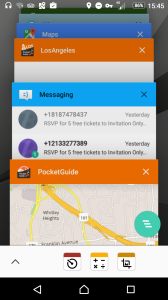Crowdsourced: navigation & location-based services
 Once you switch the smartphone off from email and social media network, you can notice better when and how you’re crowdsourced. By this, I mean that use of applications to contribute data is sometimes clearer as the phone becomes less of communication technology and more of information technology (while most of the time it is an information and communication mixed together).
Once you switch the smartphone off from email and social media network, you can notice better when and how you’re crowdsourced. By this, I mean that use of applications to contribute data is sometimes clearer as the phone becomes less of communication technology and more of information technology (while most of the time it is an information and communication mixed together).
During my last year summer break, while switching off, I was able to notice three types of crowdsourcing that were happening as I was mostly using my phone for tourism: the set of applications that I used during the period was mostly Google Maps, Waze, and Sygic for navigation (Sygic is an offline satnav app that uses local storage, especially useful as you go away from signal – as in the case of travelling to Yosemite above). I also used TripAdvisor to find restaurants or plan visits, and in a tour of Hollywood, we’ve downloaded a guided tour by “PocketGuide Audio Travel Guide”. There were also the usual searches on Google to find the locations of swimming pools, train schedule, boat tours and all the other things that you do when you’re travelling.
The first type of being crowdsourced that I knew was there but I couldn’t notice was with every action that I’ve done with the phone. Searches, visiting websites and all the other things that I’ve done as long as the phone was on. I know that they are there, but I have no idea who is collecting the traces – I can be quite certain that the phone company and Google were getting information, but I can’t tell for sure – so that’s hidden crowdsourcing.
The second type is being passively crowdsourced – I know that it happened, and I can so rt of guess what information is being recorded, but I didn’t need any action to make it happen. Checking the map on the way back to the airport at the end of the journey, show how geolocated images and information are being put on the map. Google Maps assume that I visited known locations, mostly commercials, along the way. It was especially funny to stay in a suburban place that happened to be the registered address of a business, and every time we went to it, Google insisted that we’re visiting the business (which doesn’t physically exist in the place). At least with this passive crowdsourcing, I am knowingly contributing information – and since I’m benefiting from the navigation guidance of Google Maps as I drive along, it is a known transaction (regardless of power relationship and fairness).
rt of guess what information is being recorded, but I didn’t need any action to make it happen. Checking the map on the way back to the airport at the end of the journey, show how geolocated images and information are being put on the map. Google Maps assume that I visited known locations, mostly commercials, along the way. It was especially funny to stay in a suburban place that happened to be the registered address of a business, and every time we went to it, Google insisted that we’re visiting the business (which doesn’t physically exist in the place). At least with this passive crowdsourcing, I am knowingly contributing information – and since I’m benefiting from the navigation guidance of Google Maps as I drive along, it is a known transaction (regardless of power relationship and fairness). 
the third and final type of process was active crowdsourcing. This was when I was aware of what I’m contributing, to which system, and more or less how. When I provided an image to Google Local Guides I knew that it will be shared (I am though, hugely surprised how many times it was viewed, but I’ll write about Local Guides in a different post). I was also actively contributing to TripAdvisor about some place near Venice Beach. A certain surprise also came from Waze, which, in a day of experiencing Los Angeles famous traffic, provided me with a message that ‘I’m one of the top contributors on this route’ after 3 reports. Of course, I can’t tell if this message is real, but if 3 reports are enough to make you a top contributor, the number of reporting participants must be very low.
Few other observations: it was interesting to see how embedded is the consideration that you will be online all the time – Google Maps suggested to download a route when they had information that part of the journey will not be covered by mobile signal, but the application didn’t behave well with offline data (Sygic did). Both Waze and Google Maps behaved very erratically when I passed a blocked slip road and didn’t follow their navigation guidance. For quite a distance, they continue to suggest that I turn around and use the blocked road.
The other aspect that was very apparent is the built in methodological individualism of all these apps – even though I was only with my partner, we found the PocketGuide Audio Travel Guide awkward to use – we wanted to experience the tour (which is interesting) together. The app is just difficult to use when you try to go with other people and discuss things together. This is partially how phones are thought of, but touring is not only a solitary experience…
